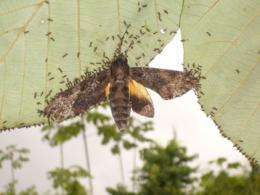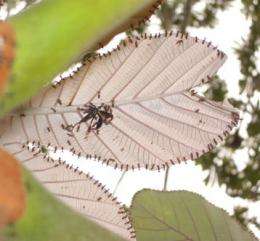'Velcro' effect in Guianese ants

In Guiana, symbiosis between Azteca ants and the Cecropia tree (or trumpet tree) is frequent. However, a surprising discovery has been made: one species of ant (Azteca andreae) uses the "Velcro" principle to cling on firmly to the leaves of Cecropia and thus capture very large prey.
These results, obtained by Alain Dejean's team from the Laboratoire Ecologie des ForEts de Guyane (CNRS, France), were published in the journal PLoS ONE on 25 June 2010.
Cecropia, the emblematic tree of Guiana also known as trumpet tree, has developed a symbiotic relationship with arboreal ants of the genus Azteca. Cecropia provides a nesting place (in the hollow stalks) and some food to these small ants, which in return, protect the host tree from defoliators.
Dejean's team focused on the interactions between Cecropia obtusa and a species of Azteca recently described in French Guiana: Azteca andreae. The ants of this species do not feed from the nutritive bodies supplied by the host tree, but have instead developed a hunting strategy based on a very elaborate social organization.

The workers line up side by side beneath the leaf margins of the tree and wait for any prey to alight, either to seek shelter or to attack the tree's foliage. The scientists discovered that, in this position, the ants grip firmly onto the leaves using the “Velcro” principle. In fact, the underside of the leaves is downy, which constitutes the velvet-like surface to which the hook-shaped claws of the workers attach.
Thanks to this “Velcro” principle, an ant can support up to 5,000 times its own bodyweight. A group of workers can capture very large prey, the largest encountered being a locust weighing 18.61 g, i.e. 13,350 times the mean weight of a single worker.
More information: Dejean A., Leroy C., Corbara B., Roux O., Céréghino R., Orivel J. & Boulay R. Arboreal ants use the “Velcro® principle” to capture very large prey. PloS One, 23 June 2010.
Provided by CNRS

















